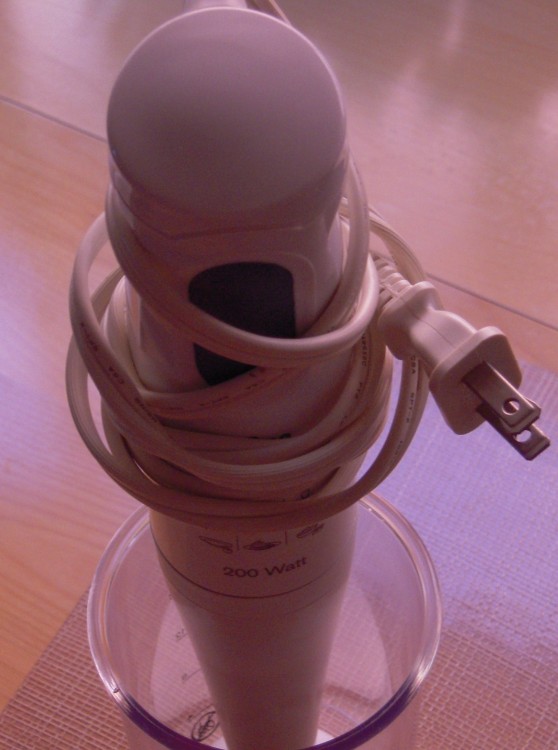
Hand blender
Word up: part with the $20 it will take to get a hand blender, aka immersion blender, into the house.
There are things I can do easily with this guy that make it one of the most-used kitchen gadgets I own. To be honest with you, I have two. I got my father one some years ago and it came back to me when he passed away. Thus, my own, which was stained red from a tomato product years ago, is used for things with natural dyes, and the other one is kept looking pretty.
Unless you plan on catering or otherwise making large quantities and/or feel more comfortable having something made by KitchenAid, I would not bother with the ~$50 KitchenAid model, though it is nice that its blending shaft is stainless steel and won’t turn purple or red, which the white ones will do, believe me, if you work with beets or pasta sauce. I suggest you get the 200 watt Braun, which I have not been able to kill after years of hard use and dishwasher cleaning. Given that the power (wattage) of the Braun and the KitchenAid (KHB100) is identical, the only thing you’ll give up is the stainless steel and about an inch of blending shaft length. Note that the KitchenAid KBH300 costs about $100 but is the same blender with a boatload of attachments. Since I have no intention of attempting to use my immersion blender for anything other than immersion blending, I don’t need all that stuff.
Here are a few things you can use this for:
1) Thickening bean or veggie soups by blending all or part of the contents right in the pot
2) Giving body to homemade tomato sauce so it’s not half tomato chunks and half liquid
3) Blending thickening agents (and veggies cooked with meats) into cooking juices, which will result in smooth gravies
4) Making cold sauces and spreads with things like roasted peppers, eggplants and nuts
5) Making fresh mayonnaise
6) Repairing broken sauces, like an anglaise
7) Making baby food
The first item on the list is alone worth the cost of admission because it prevents the need to transfer hot liquid to and from a blender.
When you use a hand blender with hot liquids, just be sure to get enough immersion so you don’t splatter things all over yourself and get burned. Practice with cold water, and try to use containers that give you height. The little cup these units come with are great for blending small amounts of dressing, and you can stand the blender in the cup on your countertop when not in use. The blade is on the end of a cylindrical piece that disattaches from the power unit, and can be cleaned in the top rack of a dishwasher.
I first used this tool in culinary school, though pro units are over three feet long and can puree gallons of soup quickly. Professional cooks call these monsters “burr mixers, ” which may be an anglicized version of the brand name “Bermixer,” used by European manufacturer Dito Electrolux. This is only a guess, and I’m trying to prove it.
For an interesting look at the invention and history of this appliance, check out the Bamix website.
Chalk up yet another great idea to the Swiss.
UPDATE on 28 September 2009: I saw Cuisinart SmartStick handblenders for $30 at Costco today. They have a stainless steel blending shaft and come with a bunch of attachments, though note that they are no more powerful (at 200 watts) and only a scant half an inch longer than the little Braun I discussed.
